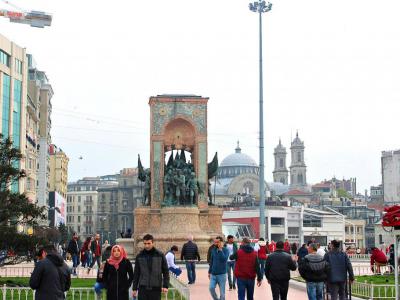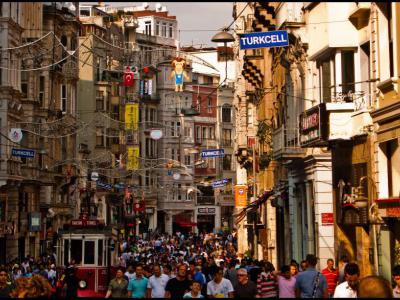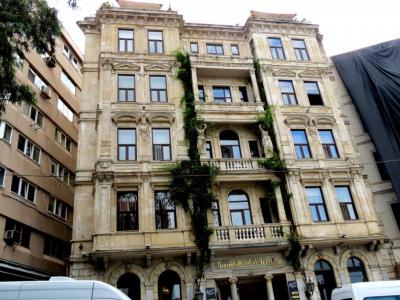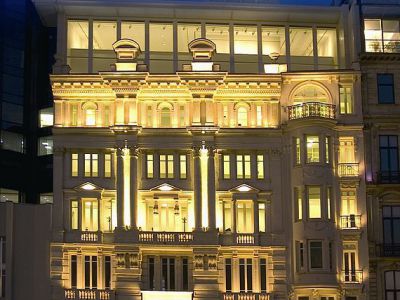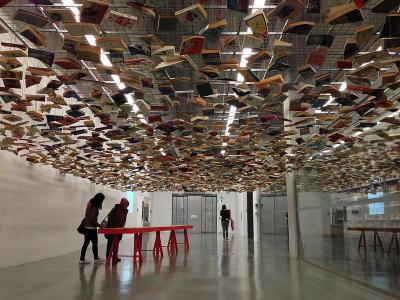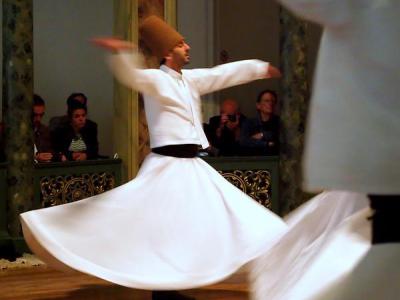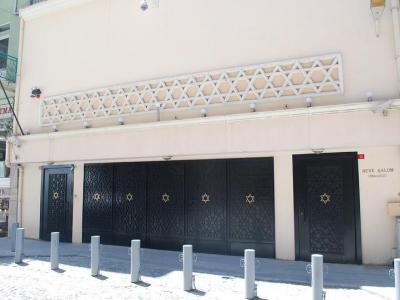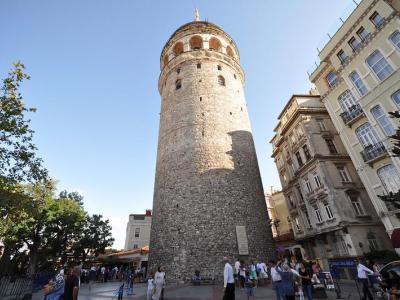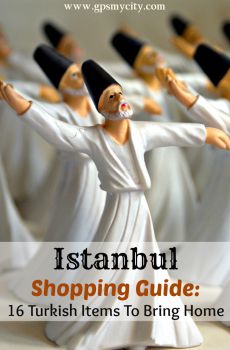Audio Guide: Old European Quarter Walk (Self Guided), Istanbul
Back in the Ottoman era, the Beyoğlu neighborhood (then known as Pera), together with Galata, formed the stylish European Quarter of Istanbul. Home to embassies, trading houses, and Parisian-style apartment blocks, it all looks like it wandered in straight from the French capital. This area was where the city’s non-Islamic communities worked, lived, and possibly argued over the best pastries...
Then came the Orient Express, steaming its way from Paris to Aleppo like a celebrity rail tour. Tourists poured in. Hotels popped up. Beyoğlu was the place to be — up until the 20th century tossed in a dramatic roller-coaster of ups and downs, and those moments of uncertainty.
The comeback story began in 1990, when Istiklal (or Independence) Avenue was pedestrianized to become a people-only runway. Chic boutiques, classy cafés, and indie cinemas sprang up like mushrooms, manifesting “urban renaissance.” Look closely and you’ll still spot the signatures of Greek and Armenian architects basking on those glamorous façades.
The district’s unofficial main plaza — Taksim Square — is part transit hub, part social stage, and always in motion. From there, Istiklal Avenue leads you to treats like Çiçek Passage, a floral-themed historic arcade where the ambiance is nearly as delicious as dinner.
Culture hunters also have plenty to cheer for: sip history at the Grand Hotel de Londres Bar, admire treasures at the Pera Museum, or strike a more modern pose inside the Istanbul Modern Art Museum. Follow Galip Dede Street downhill for a dash of spiritual history at the Galata Mevlevi Museum — or step quietly into Neve Shalom Synagogue, a cornerstone of Jewish life in the city.
And of course, the scene-stealing moment: Galata Tower. Climb up, gaze out, and pretend the city below is applauding your arrival.
In sum, what you see in this patch of Istanbul is a running saga of reinvention. A full account of its attractions would require an entire guidebook, which may well be outdated as soon as it's written, so it's better to explore than over-explain. Just keep walking… the rest of the story is waiting right around the corner.
Then came the Orient Express, steaming its way from Paris to Aleppo like a celebrity rail tour. Tourists poured in. Hotels popped up. Beyoğlu was the place to be — up until the 20th century tossed in a dramatic roller-coaster of ups and downs, and those moments of uncertainty.
The comeback story began in 1990, when Istiklal (or Independence) Avenue was pedestrianized to become a people-only runway. Chic boutiques, classy cafés, and indie cinemas sprang up like mushrooms, manifesting “urban renaissance.” Look closely and you’ll still spot the signatures of Greek and Armenian architects basking on those glamorous façades.
The district’s unofficial main plaza — Taksim Square — is part transit hub, part social stage, and always in motion. From there, Istiklal Avenue leads you to treats like Çiçek Passage, a floral-themed historic arcade where the ambiance is nearly as delicious as dinner.
Culture hunters also have plenty to cheer for: sip history at the Grand Hotel de Londres Bar, admire treasures at the Pera Museum, or strike a more modern pose inside the Istanbul Modern Art Museum. Follow Galip Dede Street downhill for a dash of spiritual history at the Galata Mevlevi Museum — or step quietly into Neve Shalom Synagogue, a cornerstone of Jewish life in the city.
And of course, the scene-stealing moment: Galata Tower. Climb up, gaze out, and pretend the city below is applauding your arrival.
In sum, what you see in this patch of Istanbul is a running saga of reinvention. A full account of its attractions would require an entire guidebook, which may well be outdated as soon as it's written, so it's better to explore than over-explain. Just keep walking… the rest of the story is waiting right around the corner.
How it works: Download the app "GPSmyCity: Walks in 1K+ Cities" from Apple App Store or Google Play Store to your mobile phone or tablet. The app turns your mobile device into a personal tour guide and its built-in GPS navigation functions guide you from one tour stop to next. The app works offline, so no data plan is needed when traveling abroad.
Old European Quarter Walk Map
Guide Name: Old European Quarter Walk
Guide Location: Turkey » Istanbul (See other walking tours in Istanbul)
Guide Type: Self-guided Walking Tour (Sightseeing)
# of Attractions: 10
Tour Duration: 2 Hour(s)
Travel Distance: 2.4 Km or 1.5 Miles
Author: DanaOffice
Sight(s) Featured in This Guide:
Guide Location: Turkey » Istanbul (See other walking tours in Istanbul)
Guide Type: Self-guided Walking Tour (Sightseeing)
# of Attractions: 10
Tour Duration: 2 Hour(s)
Travel Distance: 2.4 Km or 1.5 Miles
Author: DanaOffice
Sight(s) Featured in This Guide:
- Taksim Square
- Istiklal Caddesi (Independence Avenue)
- Cicek Pasaji (Flower Passage)
- Grand Hotel de Londres Bar
- Pera Museum
- Istanbul Modern (Art Museum)
- Galip Dede Caddesi (Street)
- Galata Mevlevi Museum
- Neve Shalom Synagogue
- Galata Tower
1) Taksim Square
Every major city loves to show off its main square, and Istanbul’s Taksim doesn’t just show off — it practically shimmies. Its name means “division” or “distribution,” a nod to the days when the city’s vital water supply lines gathered here right beneath everyone’s feet. Today, it’s more about the distribution of selfies, street snacks, and general human chaos — the good kind...
This place is also the grand starting point for Istiklal Avenue, a pedestrian shopping street that could drain anyone’s wallet and patience in equal measure. Yes, you’ll spot the usual international fast-food chains, but don’t worry — kebabs, baklava, roasted corn, warm chestnuts, and stretchy Turkish ice-cream are all here to remind you which country you’re in. With hundreds of shops crammed along the route, Taksim is also a transportation jackpot: metro, tram, buses, and taxis swirling around like pieces in a very caffeinated board game.
At the heart of the square stands the Monument to the Republic, surrounded by proud locals snapping photos of Mustafa Kemal Atatürk — father of the nation, reformer, and champion of stern yet photogenic poses. One side shows him as a soldier, the other as a statesman; both sides insist he knew what he was doing...
When the sun dips, expect the soundtrack to shift. Groups gather to sing, dance, and fill the air with more energy than a double-shot Turkish coffee. The transformation is instant and addictive.
Quick tip: the side streets hide great cafés and quirky shops worth a detour. And if you hail a taxi, glance at the meter first — consider it your pre-ride cardio. Beware of scammers and pickpockets — keep your belongings close, your eyes open, and enjoy the spectacle that is Taksim Square.
This place is also the grand starting point for Istiklal Avenue, a pedestrian shopping street that could drain anyone’s wallet and patience in equal measure. Yes, you’ll spot the usual international fast-food chains, but don’t worry — kebabs, baklava, roasted corn, warm chestnuts, and stretchy Turkish ice-cream are all here to remind you which country you’re in. With hundreds of shops crammed along the route, Taksim is also a transportation jackpot: metro, tram, buses, and taxis swirling around like pieces in a very caffeinated board game.
At the heart of the square stands the Monument to the Republic, surrounded by proud locals snapping photos of Mustafa Kemal Atatürk — father of the nation, reformer, and champion of stern yet photogenic poses. One side shows him as a soldier, the other as a statesman; both sides insist he knew what he was doing...
When the sun dips, expect the soundtrack to shift. Groups gather to sing, dance, and fill the air with more energy than a double-shot Turkish coffee. The transformation is instant and addictive.
Quick tip: the side streets hide great cafés and quirky shops worth a detour. And if you hail a taxi, glance at the meter first — consider it your pre-ride cardio. Beware of scammers and pickpockets — keep your belongings close, your eyes open, and enjoy the spectacle that is Taksim Square.
2) Istiklal Caddesi (Independence Avenue) (must see)
Welcome to the most organic facet of modern Istanbul — Istiklal Avenue — a mosaic of cultures and ideas that feels both Turkish and unmistakably European. Indeed, here East meets West, sharing a drink, grabbing a bite, and staying up past midnight. In this collision of life, languages, and late-night pastry shops, embassies stand shoulder to shoulder with indie bookstores, street musicians jam beside polished art galleries, and the air hums with both espresso machines and the murmur of ten thousand footsteps.
Moving through Istiklal, you can't miss the sight capturing everyone’s attention — the nostalgic red tram. The only vehicle allowed here, it quietly glides down the middle, linking Taksim and Tünel squares. Its slow pace contrasts with the endless flow of people from every corner of the world. Riding it isn’t about distance; it’s about presence — sharing a moment with Istanbul’s glorious chaos.
Look left, right, and a little skyward. All along this avenue, history and art live side by side. Historic cinemas such as Atlas and Beyoğlu still light their marquees, and elegant passages like Çiçek and Hazzopulo recall the Belle Époque charm of old Istanbul. The Church of Saint Antoine, with its Venetian Gothic façade, stands as a reminder of the city’s layered faiths and communities. Nearby, galleries such as SALT Beyoğlu, ARTER, and the Mısır Apartments bring contemporary energy to the street’s historic architecture.
Take a turn down any alley, and Istanbul will reward your curiosity. Here, the tempo softens with small smoky taverns, cafés, and rooftop terraces inviting visitors to pause — to taste, to listen, to observe. The hum of conversation, the scent of coffee, the echo of live music: all merge into one continuous story of Istanbul — vibrant, diverse, and always in motion. Indeed, this street doesn’t walk — it dances.
Just remember — keep your wallet close, your eyes anywhere but in front of you (a neat trick that clears your path), and avoid walking the minor alleys after midnight.
Moving through Istiklal, you can't miss the sight capturing everyone’s attention — the nostalgic red tram. The only vehicle allowed here, it quietly glides down the middle, linking Taksim and Tünel squares. Its slow pace contrasts with the endless flow of people from every corner of the world. Riding it isn’t about distance; it’s about presence — sharing a moment with Istanbul’s glorious chaos.
Look left, right, and a little skyward. All along this avenue, history and art live side by side. Historic cinemas such as Atlas and Beyoğlu still light their marquees, and elegant passages like Çiçek and Hazzopulo recall the Belle Époque charm of old Istanbul. The Church of Saint Antoine, with its Venetian Gothic façade, stands as a reminder of the city’s layered faiths and communities. Nearby, galleries such as SALT Beyoğlu, ARTER, and the Mısır Apartments bring contemporary energy to the street’s historic architecture.
Take a turn down any alley, and Istanbul will reward your curiosity. Here, the tempo softens with small smoky taverns, cafés, and rooftop terraces inviting visitors to pause — to taste, to listen, to observe. The hum of conversation, the scent of coffee, the echo of live music: all merge into one continuous story of Istanbul — vibrant, diverse, and always in motion. Indeed, this street doesn’t walk — it dances.
Just remember — keep your wallet close, your eyes anywhere but in front of you (a neat trick that clears your path), and avoid walking the minor alleys after midnight.
3) Cicek Pasaji (Flower Passage)
Roughly halfway down the ever-buzzing Istiklal Avenue lies a string of elegant arcades, half bathed in sunlight, half tucked under glass. The most iconic of them all is the Çiçek (or “Flower”) Passage. Opened in 1876, this glamorous arcade was Istanbul’s answer to Parisian chic, complete with fancy shops and polished apartments for those who fancied themselves the crème de la crème of Ottoman society.
Then came 1917, and history took a dramatic turn. As the Russian Revolution scattered its nobility across Europe, some of those exiled and impoverished aristocrats — baronesses included — landed here, selling flowers to make ends meet. By the 1940s, the building had been completely taken over by flower shops, giving the passage its new name and its delicate perfume of nostalgia.
These days, the Flower Passage has had a facelift or two, but it still oozes atmosphere. Wander beneath its glass canopy, spot the faded signs of past decades, or pull up a chair at one of the bustling taverns (known locally as "meyhanes") serving up seafood, chatter, and raki — the local anise spirit that can either charm or floor you, depending on your water-to-raki ratio...
By evening, the lights glow warm, musicians weave through the tables, and laughter spills out onto the street. It may no longer be the haunt of baronesses, but it remains one of Istanbul’s most intoxicating blooms.
Then came 1917, and history took a dramatic turn. As the Russian Revolution scattered its nobility across Europe, some of those exiled and impoverished aristocrats — baronesses included — landed here, selling flowers to make ends meet. By the 1940s, the building had been completely taken over by flower shops, giving the passage its new name and its delicate perfume of nostalgia.
These days, the Flower Passage has had a facelift or two, but it still oozes atmosphere. Wander beneath its glass canopy, spot the faded signs of past decades, or pull up a chair at one of the bustling taverns (known locally as "meyhanes") serving up seafood, chatter, and raki — the local anise spirit that can either charm or floor you, depending on your water-to-raki ratio...
By evening, the lights glow warm, musicians weave through the tables, and laughter spills out onto the street. It may no longer be the haunt of baronesses, but it remains one of Istanbul’s most intoxicating blooms.
4) Grand Hotel de Londres Bar
Imagine flapper-era glamour meeting Istanbul skyline... This 1920s-style rooftop bar still reigns as one of the city’s most authentic hideouts—no pretension, no influencer armies—just locals, expats, and the occasional stray breeze carrying the scent of the Bosphorus. Whether it’s a frosty beer or a glass of Turkish tea, everything tastes better when paired with that glittering view of the Golden Horn and the Old City.
The lounge bar serves drinks and meals from 4 pm to late at night for those who missed dinner time. Come around sunset—say, between 7 and 9 pm—and the city puts on a free show. Minarets glow, ferries drift like lazy fireflies, and Istanbul’s skyline slips from gold to indigo. The menu is friendly to your wallet, and the relaxed crowd (largely devoid of tourists) makes it easy to linger longer than you planned.
Downstairs, the building tells another story. Once a refined city hotel for 19th-century European travelers (particularly the Brits, who had a soft spot for it), it still wears its age gracefully. The walls whisper history in oil paint and faded frames—worth a pause as you wander the stairway.
And if the weather turns brisk, retreat indoors. The main hall and lobby bar still hum with that quiet, timeworn charm that makes you want to order coffee slowly, as if you’re sharing it with the ghosts of Istanbul’s grand past...
The lounge bar serves drinks and meals from 4 pm to late at night for those who missed dinner time. Come around sunset—say, between 7 and 9 pm—and the city puts on a free show. Minarets glow, ferries drift like lazy fireflies, and Istanbul’s skyline slips from gold to indigo. The menu is friendly to your wallet, and the relaxed crowd (largely devoid of tourists) makes it easy to linger longer than you planned.
Downstairs, the building tells another story. Once a refined city hotel for 19th-century European travelers (particularly the Brits, who had a soft spot for it), it still wears its age gracefully. The walls whisper history in oil paint and faded frames—worth a pause as you wander the stairway.
And if the weather turns brisk, retreat indoors. The main hall and lobby bar still hum with that quiet, timeworn charm that makes you want to order coffee slowly, as if you’re sharing it with the ghosts of Istanbul’s grand past...
5) Pera Museum
Step off the Orient Express and back into time (well, metaphorically speaking). A century ago, three grand hotels ruled Istanbul’s hospitality scene: the Pera Palace, the Grand Hotel de Londres, and the Bristol. While the first two still survive as hotels, the third one—the Bristol—since 2005, has been reincarnated as the Pera Museum—a cultural blend of Ottoman opulence, international flair, and, quite literally, ancient weights and measures.
Inside, the museum unfolds five floors with a sense of quiet precision. Two levels are devoted to permanent collections—featuring antiquities, Anatolian treasures, and Oriental art. On the second floor, the star of the show is a $3.5-million "The Tortoise Trainer" painting by Osman Hamdi Bey. Meditation on patience, this painting somehow feels right at home in a city famous for its slow traffic. The upper galleries rotate exhibitions by global icons—Joan Miró, Andy Warhol, and their artistic kin—so it’s always worth checking what’s hanging here before you go.
The museum's layout is straightforward, the staff is friendly and refreshingly not hovering about while you are viewing, plus the ground-floor café delivers a caffeine fix with a side of people-watching. The gift shop tempts with design-forward trinkets that your wallet might object to, but your suitcase will thank you for.
Beyond exhibitions, the museum nurtures creativity through workshops for kids and Pera Film, a program screening everything from avant-garde shorts to documentaries. In short, this is one former hotel that’s still checking in guests—just on a more imaginative wavelength.
Inside, the museum unfolds five floors with a sense of quiet precision. Two levels are devoted to permanent collections—featuring antiquities, Anatolian treasures, and Oriental art. On the second floor, the star of the show is a $3.5-million "The Tortoise Trainer" painting by Osman Hamdi Bey. Meditation on patience, this painting somehow feels right at home in a city famous for its slow traffic. The upper galleries rotate exhibitions by global icons—Joan Miró, Andy Warhol, and their artistic kin—so it’s always worth checking what’s hanging here before you go.
The museum's layout is straightforward, the staff is friendly and refreshingly not hovering about while you are viewing, plus the ground-floor café delivers a caffeine fix with a side of people-watching. The gift shop tempts with design-forward trinkets that your wallet might object to, but your suitcase will thank you for.
Beyond exhibitions, the museum nurtures creativity through workshops for kids and Pera Film, a program screening everything from avant-garde shorts to documentaries. In short, this is one former hotel that’s still checking in guests—just on a more imaginative wavelength.
6) Istanbul Modern (Art Museum)
Here, on the edge of the Sea of Marmara, Istanbul reimagines itself. The Istanbul Modern is a thought-provoking manifesto in glass and light that gleams with a cool, contemporary shimmer. Inside its walls — a sharp contrast to the centuries-old minarets, domes, and Ottoman arches — this museum gives voice to the artists who’ve been left out of the global modern art conversation, displaying their work in a space that feels equal parts gallery, think-tank, and seaside escape...
Housed in a former maritime warehouse, it keeps things humble on the exterior — looking more like a cargo terminal than a castle. But step inside, and the openness, the light, the views of the city skyline all make sense.
The museum stretches across two airy floors. The upper level is home to its permanent collection — a vivid showcase of Turkish creativity — alongside classrooms, a design-forward gift shop, and a café with waterfront calm. Below, rotating exhibitions, Istanbul Modern Cinema, and a serene library keep the dialogue between film, art, and memory alive.
The ticket may cost a little extra by local standards, but what you gain here — the atmosphere and curation — more than balances the scales. And that nice little café – a must for any museum worth its salt – delivers a pleasant addition to a day of cultural exploration without emptying your wallet.
You can wander freely or take an audio guide — available in both English and Turkish — that will walk you through the highlights in about 45 minutes, making this a perfect pit stop for both casual wanderers and deep thinkers.
Indeed, if you're looking for a fresh angle on Turkish identity and artistic expression, this is the place. And before you leave, stop by the gift shop — a hidden trove of inspired keepsakes, including jewelry that might just rival the art upstairs...
Housed in a former maritime warehouse, it keeps things humble on the exterior — looking more like a cargo terminal than a castle. But step inside, and the openness, the light, the views of the city skyline all make sense.
The museum stretches across two airy floors. The upper level is home to its permanent collection — a vivid showcase of Turkish creativity — alongside classrooms, a design-forward gift shop, and a café with waterfront calm. Below, rotating exhibitions, Istanbul Modern Cinema, and a serene library keep the dialogue between film, art, and memory alive.
The ticket may cost a little extra by local standards, but what you gain here — the atmosphere and curation — more than balances the scales. And that nice little café – a must for any museum worth its salt – delivers a pleasant addition to a day of cultural exploration without emptying your wallet.
You can wander freely or take an audio guide — available in both English and Turkish — that will walk you through the highlights in about 45 minutes, making this a perfect pit stop for both casual wanderers and deep thinkers.
Indeed, if you're looking for a fresh angle on Turkish identity and artistic expression, this is the place. And before you leave, stop by the gift shop — a hidden trove of inspired keepsakes, including jewelry that might just rival the art upstairs...
7) Galip Dede Caddesi (Street)
It won't be an exaggeration to call this narrow, cobblestoned slope in Istanbul’s Tünel district the city’s unofficial temple to sound. Musicians and music-lovers of all stripes have come here for years to worship the art of noise. On this street, every other doorway seems to hum, strum, or jingle, and the shops spill over with instruments of every kind, from pocket-sized percussion to showpiece ouds gleaming in the window.
A Mey pipe here goes for around $200 apiece, while an entry-level, budget model of baglama (a plucked string instrument) might set you back $400, which is not bad, come to think of it, for something you can serenade the sunset with...
Weekdays in the early afternoon, when it's not very crowded, are the best time to visit. Between the music stores, you’ll find quirky craft boutiques and artsy hideouts selling everything from handmade jewelry to one-of-a-kind keepsakes. The air buzzes with color, chatter, and just enough chaos to make it feel alive.
And when the scent of fresh soap hits you, that’s the Home Spa store — stocked with organic oils, cheerful bathrobes, and enough aromatic temptation to make you reconsider your suitcase space.
A final word of wisdom: stop at one of the juice stands along the way. A splash of fresh orange or pomegranate will keep you cool, hydrated, and ready to keep jamming down the street.
A Mey pipe here goes for around $200 apiece, while an entry-level, budget model of baglama (a plucked string instrument) might set you back $400, which is not bad, come to think of it, for something you can serenade the sunset with...
Weekdays in the early afternoon, when it's not very crowded, are the best time to visit. Between the music stores, you’ll find quirky craft boutiques and artsy hideouts selling everything from handmade jewelry to one-of-a-kind keepsakes. The air buzzes with color, chatter, and just enough chaos to make it feel alive.
And when the scent of fresh soap hits you, that’s the Home Spa store — stocked with organic oils, cheerful bathrobes, and enough aromatic temptation to make you reconsider your suitcase space.
A final word of wisdom: stop at one of the juice stands along the way. A splash of fresh orange or pomegranate will keep you cool, hydrated, and ready to keep jamming down the street.
8) Galata Mevlevi Museum
In Istanbul, where history hums under every stone, this former tekke (or a Whirling Dervish lodge) turned museum offers both a quiet lesson in mysticism and a front-row seat to transcendence in motion. This is one of the few places in town where visitors can still witness an authentic Whirling Dervish performance, every Sunday at 5 p.m.
To get the most out of the experience, explore the museum first. It helps decode what you’ll later see spinning before your eyes. Alternatively, you can freely walk around the grounds, including a small cemetery where the former tekke members are interred.
The first thing to say about the Sema ceremony is that it isn’t some staged tourist gimmick with a soundtrack and sparkles. It’s a religious ritual, slow-blooming and precise, moving from stillness to a hypnotic rhythm. Each bow, step, and swirl holds meaning—symbolizing humanity’s inner journey toward understanding of our existence. What begins in silence ends in motion, tracing the soul’s own circular pilgrimage through life and devotion.
Handout brochures explain the basics, and the 50-minute performance is an abbreviated version of the three-hour ritual. Come early if you’d like a seat with a clear view—or simply stand, which feels just as fitting for something this sacred.
A practical note from the realm of logistics: museum tickets are sold at a kiosk inside the grounds, just beyond the information office. As for the ceremony itself, its tickets appear Sunday noon at a modest table outside the main gate—proof that even profound spiritual experiences in Istanbul come with a side of sidewalk charm...
To get the most out of the experience, explore the museum first. It helps decode what you’ll later see spinning before your eyes. Alternatively, you can freely walk around the grounds, including a small cemetery where the former tekke members are interred.
The first thing to say about the Sema ceremony is that it isn’t some staged tourist gimmick with a soundtrack and sparkles. It’s a religious ritual, slow-blooming and precise, moving from stillness to a hypnotic rhythm. Each bow, step, and swirl holds meaning—symbolizing humanity’s inner journey toward understanding of our existence. What begins in silence ends in motion, tracing the soul’s own circular pilgrimage through life and devotion.
Handout brochures explain the basics, and the 50-minute performance is an abbreviated version of the three-hour ritual. Come early if you’d like a seat with a clear view—or simply stand, which feels just as fitting for something this sacred.
A practical note from the realm of logistics: museum tickets are sold at a kiosk inside the grounds, just beyond the information office. As for the ceremony itself, its tickets appear Sunday noon at a modest table outside the main gate—proof that even profound spiritual experiences in Istanbul come with a side of sidewalk charm...
9) Neve Shalom Synagogue
Blink and you might miss it—yet, this modest building carries more stories than many of Istanbul’s grand palaces. Just off Istiklal Street, amid cafés and boutiques, stands the only Jewish museum in Turkey, quietly guarding centuries of memory. Behind its discreet façade lie traces of survival—bullet holes and bomb scars from attacks in 1986, 1992, and 2003—now covered in steel and reminding of resilience rather than ruin.
Inside, the museum paints a vivid picture of Jewish life woven through Ottoman and Turkish history. Exhibits trace how the Jewish community found a home here after exile, contributing to art, trade, and science, while navigating the city’s shifting empires. It’s a space that celebrates coexistence as much as endurance.
The synagogue itself might not charm you at first glance, but step in and look up—the stained-glass windows shimmer with color, crafted in the UK’s Academy of Art, and above you hangs an eight-ton chandelier, a gift from Buenos Aires’ Jewish community, which has itself sustained brutal attacks over the years. Together, they cast a light that feels both sacred and unbreakable.
One practical note before you visit: you won’t need an appointment, but you will need your passport. Expect a brief security screening—proof that even in a house of peace, vigilance is part of the architecture...
Inside, the museum paints a vivid picture of Jewish life woven through Ottoman and Turkish history. Exhibits trace how the Jewish community found a home here after exile, contributing to art, trade, and science, while navigating the city’s shifting empires. It’s a space that celebrates coexistence as much as endurance.
The synagogue itself might not charm you at first glance, but step in and look up—the stained-glass windows shimmer with color, crafted in the UK’s Academy of Art, and above you hangs an eight-ton chandelier, a gift from Buenos Aires’ Jewish community, which has itself sustained brutal attacks over the years. Together, they cast a light that feels both sacred and unbreakable.
One practical note before you visit: you won’t need an appointment, but you will need your passport. Expect a brief security screening—proof that even in a house of peace, vigilance is part of the architecture...
10) Galata Tower (must see)
The Galata Tower, one of Istanbul’s most recognizable landmarks, rises above the city as a lasting emblem of power, endurance, and transformation. Erected in 1348 by Genoese merchants, it originally bore the name the “Tower of Christ” and served both as a watchtower and defensive stronghold for the independent Genoese colony of Galata, located across the Golden Horn from Byzantine Constantinople. Standing nine stories tall and approximately 67 meters high, the stone tower was the tallest structure of its time and offered an unmatched panoramic view of the city and sea. Even today, its circular viewing platform provides visitors with a 360-degree perspective of Istanbul’s skyline, encompassing the Bosphorus, Golden Horn, and the city’s historic landmarks.
When the Ottomans conquered Constantinople in 1453, the tower’s purpose evolved to meet new needs. Sultan Mehmed II converted it into a fire watchtower, capitalizing on its strategic vantage point to spot fires that frequently broke out in the city’s wooden neighborhoods. Over the centuries, it also served as a prison for sailors, a warehouse, and briefly as an observatory. These changing uses reflected the Ottoman practice of adapting existing structures to fit new civic or administrative functions, integrating the Genoese-built monument into the life of the empire.
Perhaps the most famous tale linked to the Galata Tower is that of Hezarfen Ahmed Çelebi, a 17th-century Ottoman aviator who reportedly leapt from its summit wearing artificial wings and glided across the Bosphorus. Though likely embellished, the story captures the inventive spirit and imagination long associated with Istanbul’s cultural identity.
Throughout its history, the tower suffered multiple fires, notably in 1794 and 1831, prompting major restorations that eventually gave it its distinctive conical roof. It continued to function as a fire lookout post until the 1960s before being restored once more and opened to the public as a museum and viewpoint.
Today, the Galata Tower remains a highlight for visitors who can ascend by elevator to its observation deck, enjoy a drink at the café, or dine at the restaurant offering evening cabaret shows. Surrounded by lively streets, music shops, and historic charm, the tower encapsulates nearly seven centuries of Istanbul’s layered heritage—where Genoese ambition, Ottoman resilience, and modern vitality meet in a single, soaring monument.
When the Ottomans conquered Constantinople in 1453, the tower’s purpose evolved to meet new needs. Sultan Mehmed II converted it into a fire watchtower, capitalizing on its strategic vantage point to spot fires that frequently broke out in the city’s wooden neighborhoods. Over the centuries, it also served as a prison for sailors, a warehouse, and briefly as an observatory. These changing uses reflected the Ottoman practice of adapting existing structures to fit new civic or administrative functions, integrating the Genoese-built monument into the life of the empire.
Perhaps the most famous tale linked to the Galata Tower is that of Hezarfen Ahmed Çelebi, a 17th-century Ottoman aviator who reportedly leapt from its summit wearing artificial wings and glided across the Bosphorus. Though likely embellished, the story captures the inventive spirit and imagination long associated with Istanbul’s cultural identity.
Throughout its history, the tower suffered multiple fires, notably in 1794 and 1831, prompting major restorations that eventually gave it its distinctive conical roof. It continued to function as a fire lookout post until the 1960s before being restored once more and opened to the public as a museum and viewpoint.
Today, the Galata Tower remains a highlight for visitors who can ascend by elevator to its observation deck, enjoy a drink at the café, or dine at the restaurant offering evening cabaret shows. Surrounded by lively streets, music shops, and historic charm, the tower encapsulates nearly seven centuries of Istanbul’s layered heritage—where Genoese ambition, Ottoman resilience, and modern vitality meet in a single, soaring monument.
Walking Tours in Istanbul, Turkey
Create Your Own Walk in Istanbul
Creating your own self-guided walk in Istanbul is easy and fun. Choose the city attractions that you want to see and a walk route map will be created just for you. You can even set your hotel as the start point of the walk.
Istanbul City Walls
One of the most elaborate fortification systems of ancient times, the Walls of Constantinople were built by Constantine the Great to protect the city, the then newly-established capital of the Eastern Roman Empire, from attacks by land and sea. Of these, only the Golden Gate, an old ceremonial gateway into the city, had survived by the late Byzantine Era when a new series of land walls were added... view more
Tour Duration: 2 Hour(s)
Travel Distance: 5.2 Km or 3.2 Miles
Tour Duration: 2 Hour(s)
Travel Distance: 5.2 Km or 3.2 Miles
Istanbul Introduction Walking Tour
Once called Byzantium, Constantinople, and New Rome, Istanbul has had more name changes over the years than a celebrity avoiding paparazzi... The largest city in Turkey and one of the world’s most historic urban centers, it straddles the Bosphorus Strait like it couldn’t decide whether to sit on its European or Asian side and ultimately opted for both. The result was a cultural smoothie... view more
Tour Duration: 2 Hour(s)
Travel Distance: 4.3 Km or 2.7 Miles
Tour Duration: 2 Hour(s)
Travel Distance: 4.3 Km or 2.7 Miles
Byzantine Heritage Walking Tour
Originated as a Greek city called Byzantium, what's now known as Istanbul initially made name as Constantinople, an Eastern Roman imperial capital whose greatness had lasted for over a millennium, from 330 AD until the Ottoman invasion in 1453.
The Byzantine Empire’s rich cultural and architectural heritage is still preserved in dazzling sites throughout the city. Away from its Islamic... view more
Tour Duration: 2 Hour(s)
Travel Distance: 2.5 Km or 1.6 Miles
The Byzantine Empire’s rich cultural and architectural heritage is still preserved in dazzling sites throughout the city. Away from its Islamic... view more
Tour Duration: 2 Hour(s)
Travel Distance: 2.5 Km or 1.6 Miles
Bosphorus Coast Walking Tour
One of the planet's most praised stretches of water, the Bosphorus is a source of great pride for Istanbulites and of admiration for travelers. The 30-km strait dividing Europe and Asia and connecting the Marmara with the Black Sea is one of the city's highlights, having been for all ages the subject of legend and art.
This self-guided walk will take you along the coast so that you... view more
Tour Duration: 3 Hour(s)
Travel Distance: 5.9 Km or 3.7 Miles
This self-guided walk will take you along the coast so that you... view more
Tour Duration: 3 Hour(s)
Travel Distance: 5.9 Km or 3.7 Miles
Asian Side and Bosphorus Walking Tour
Istanbul is the only megalopolis in the world that straddles two continents. The Bosphorus Strait splits Turkey's biggest city into two parts: European and Asian. The latter, known locally as Asya Yakası (“Asian Side”), or more commonly as Anadolu Yakası (“Anatolian Side”), is found east of the strait, geographically on the Asian mainland.
The vast Anatolian shore, wrongly... view more
Tour Duration: 2 Hour(s)
Travel Distance: 4.6 Km or 2.9 Miles
The vast Anatolian shore, wrongly... view more
Tour Duration: 2 Hour(s)
Travel Distance: 4.6 Km or 2.9 Miles
Istanbul Old City Walking Tour
The Old City of Istanbul, occupying a triangular peninsula between the Golden Horn and the Sea of Marmara, is one of the most historically layered urban areas in the world. Its evolution reflects a succession of empires that shaped its architecture, culture, and spiritual life. The city’s origins date to around 657 BC, when Greek settlers from Megara founded Byzantium for its ideal harbor and... view more
Tour Duration: 2 Hour(s)
Travel Distance: 2.3 Km or 1.4 Miles
Tour Duration: 2 Hour(s)
Travel Distance: 2.3 Km or 1.4 Miles
Useful Travel Guides for Planning Your Trip
Istanbul Shopping Guide: 16 Turkish Items To Bring Home
Istanbul, known throughout history as Byzantium and Constantinople, has been a major center of commerce and trade, a place where merchants and general folk would rush to regularly in search of exotic things. In our days, modern travelers to Istanbul are also bound to enjoy a truly magnificent...
The Most Popular Cities
/ view all



